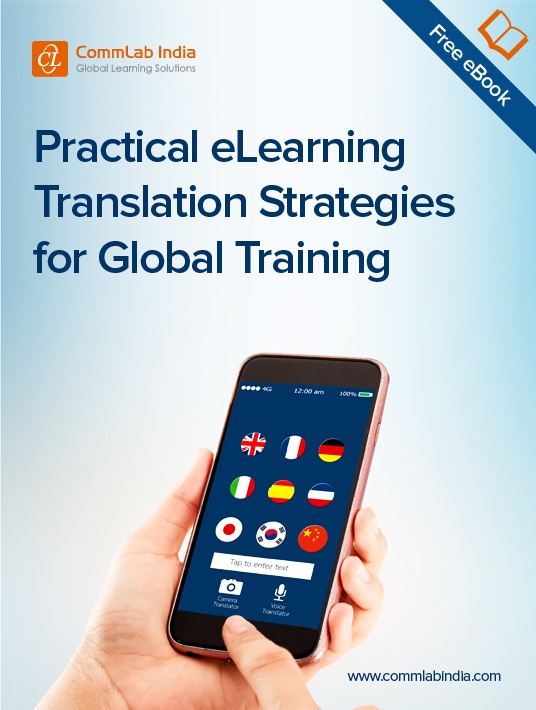The Right Tools To Make eLearning Translation Easy
It is a well-known fact that over the last two decades, many companies have moved to new shores in search of business opportunities. As business gets increasingly global, companies are compelled to translate their learning materials into the languages of their users, and technology-enabled learning resources are no exception. Are you too planning to render your eLearning courses in the languages of your learners? Read more on online translations in this insightful free eBook. Among the several aspects to be considered, one crucial element is using the right translation tools. Let us look at a few tools that help translate online courses in an efficient, cost-effective manner.

1. A Glossary Of Terms
A glossary can be used to look up unfamiliar words and their meaning. Improved use of vocabulary ensures the success of online course translations. Today, most companies use digital glossaries, and these resources can be used efficiently through automated tools. Here are a few tips to use glossaries effectively.
a. Validate The Terminology For Correct Usage
It is very important to make sure that a glossary contains the right terms in each of the target languages. You can use the services of in-house specialists to ensure that the terms are translated accurately.
Ensure the tool is organized properly and does not contain repeated words. For instance, consider the term “automobile components”. A properly organized glossary will contain the translated equivalents only for “automobile” and “components”, and not “automobile components”. Having said this, you need to see that a glossary provides definitions for all terms that need to be translated.
b. Include Only Terms That Are Specific To Your Organization
It is a best practice to include only those terms used in your organization in the glossary. Make sure that terms used in the wider industry are not included as they confuse your learners and increase the length of the glossary. For instance, if you use the term “stakeholder interaction meeting” to describe the kick-off meeting between the eLearning vendor and stakeholders, you need to include only the word “stakeholder interaction meeting” in your glossary.
c. Specify The Context In Which The Term Will Be Used
A good glossary acts as a guide to the translator and goes a long way in rendering the content accurately in the target language. It should not only list the words, their definitions, but also the contexts in which they are used. This helps use the precise equivalent in the target language. For instance, consider the word “statement”. The German equivalent of the word, when used in the sense of a formal declaration is “Stellungnahme”, whereas the word “Äußerung” is a better fit when the word “statement” is used to mean the word “remark”.
There could be some words in an eLearning course that should not be translated. For instance, in an online product training course, the brand names of products cannot be translated. It is important to provide a list of terms to the translator that must not be translated.
2. A Style Guide
A style guide is a very useful tool to enable translators of your online course ensure high quality and consistency in the output in the target language. It enables translators convey the message effectively to the learners in the target language. Here are few things you need to include in your translation style guide.
a. A List Of Desired Spellings
In many cases, a word can be written in different ways and it is important that the style guide specifies the desired spelling. For instance, the word “eLearning” can also be written as “eLearning”. Likewise, the German word “Äußerung” can also be written as “Aeusserung”. You need to clearly indicate how you want the word to be written.
b. Clear Guidelines On The Use Of Punctuation And Grammar
You need to indicate how you wish to use the following elements in the translation of your online course.
- Upper case letters.
- Attributions and citations.
- Commas.
- Format of date.
- Tenses.
c. Voice And Tone
Tell the translator what tone and voice you expect in your eLearning course – should the text sound friendly or authoritative? What is the style of the language to be used – should it be technical, educational, or academic? Providing this information will help the translator adapt the output accordingly.
3. Text-To-Speech Software
Many a time, narrators find it hard to pronounce the translated text of eLearning courses correctly. This problem can be overcome by using text-to-speech (TTS) software applications. These automated tools convert the text into spoken word, and narrators can find the correct pronunciation of words in the text.
You can also use TTS software applications to narrate your online courses. Today, thanks to rapid advances in speech synthesis technology, most TTS applications “sound” human. These applications go a long way in reducing the effort involved in and the cost of hiring a good narrator.
4. Translation Memories
A translation memory is a linguistic database that stores sentences, paragraphs, lists, and even headings that have previously been translated. These tools save translators from having to translate the terminology repeatedly, and this helps reduce the time and money needed to render the online course in target languages.
Translation memories are very useful to translate content out of context. Today, many companies use Content Management Systems (CMSs) to manage their online content. A CMS enables organizations create individual pieces of text rather than entire documents, and translation memories help render these content chunks effectively in the desired languages.
5. Digitized Lists Of Terminology
A digitized list of terminology, also known as a termbase, is a catalog of frequently used terminology, to help translators choose accurate vocabulary. A termbase helps enhance the quality of translated output, by enabling the translator maintain consistency in the use of terminology.
These online course translation tools can be scaled easily and are used in conjunction with translation memories. It is important to ensure that termbases are updated in a timely fashion to meet dynamic eLearning translation requirements.
The proper use of translation tools goes a long way in rendering the content of your eLearning courses in the desired languages, accurately, at low cost, with minimum effort.
Related Articles:
- Free eBook: Practical eLearning Translation Strategies For Global Training
- 3 Winning Strategies To Ensure Effective Global Training
- 5 Most Effective eLearning Localization Strategies
- Human Vs. Machine Translations – What You Get With Each









